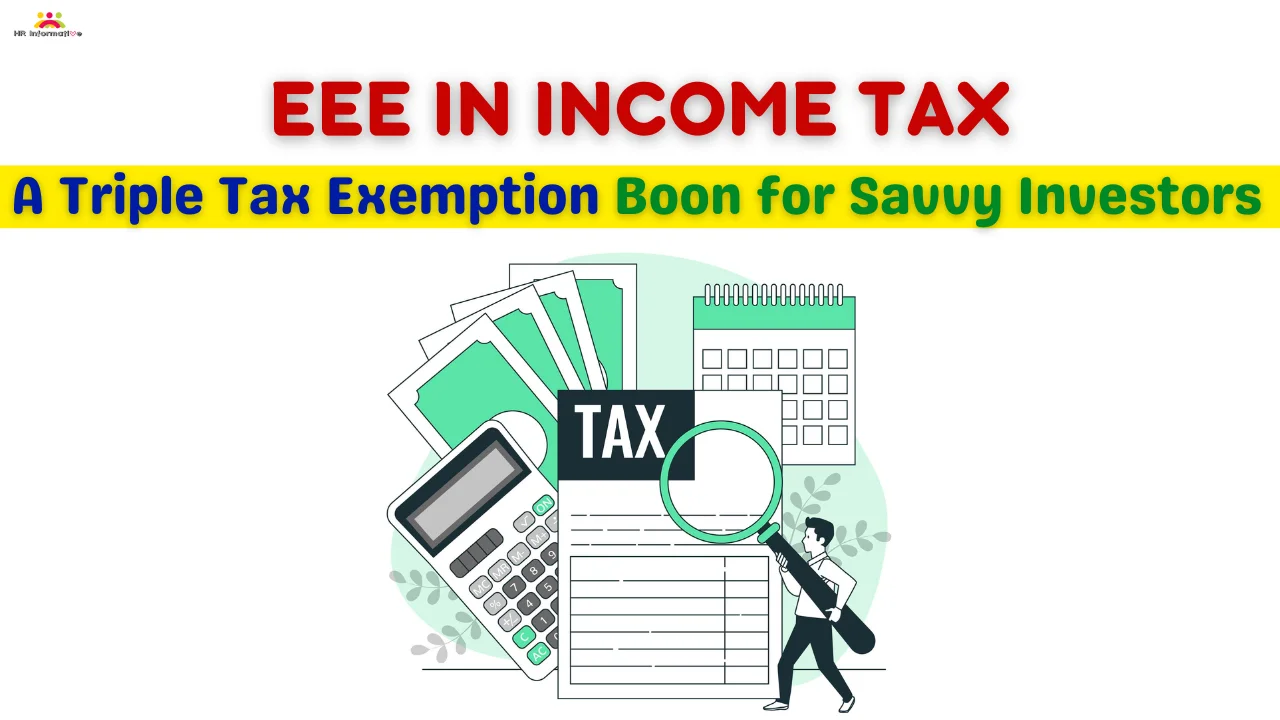In the world of income tax, a magic formula exists, one that promises triple tax exemption – EEE, or Exempt-Exempt-Exempt. It’s a powerful tool for savvy investors in India, offering significant savings and paving the way for long-term wealth creation. But what exactly is EEE, and how can you leverage its benefits? This comprehensive guide sheds light on all the crucial details, empowering you to make informed investment decisions.
The Triple Exemptions of EEE
- Exempt Investment: The initial investment you make towards an EEE-qualified instrument is itself exempt from income tax. This means a portion of your salary saved in these schemes escapes tax deductions, reducing your taxable income. Think of it as putting your money to work without losing a chunk to the taxman!
- Exempt Interest: The interest earned on your investment within the EEE scheme also enjoys tax exemption. As your money grows with compounded interest, the accrued gains remain untouched by the tax net. This allows your nest egg to flourish tax-free, accelerating your wealth accumulation.
- Exempt Maturity Proceeds: The cherry on top? The final payout – the maturity proceeds you receive upon completion of the investment tenure – is also exempt from income tax. You reap the full rewards of your investment, principal and interest combined, without facing any tax liability.
Popular EEE Investment Options
Several investment instruments fall under the EEE umbrella, offering flexibility to suit your financial goals and risk appetite. Some notable examples include:
- Public Provident Fund (PPF): A government-backed, long-term investment with attractive interest rates and tax-free maturity.
- National Pension Scheme (NPS): A government-sponsored retirement plan with tax benefits on contributions, interest, and maturity.
- Employee Provident Fund (EPF): A mandatory contribution scheme for salaried individuals, offering tax-free contributions, interest, and maturity benefits.
- Unit Linked Insurance Plans (ULIPs): Investment plans that combine insurance coverage with market-linked returns, with tax benefits on contributions, interest, and maturity under specific conditions.
- Equity Linked Savings Schemes (ELSS): Mutual funds that invest primarily in equity markets, offering tax benefits on contributions and long-term capital gains exemption.
Voluntary Provident Fund (VPF), Features, Benefits, Eligibility, Contribution, Process to Open
Benefits of EEE
- Reduced Tax Outgo: EEE allows you to lower your taxable income, potentially leading to a lower tax bracket and reduced tax liability.
- Greater Wealth Accumulation: The triple exemption allows your money to grow faster due to tax-free compounding, boosting your long-term wealth creation.
- Flexibility: EEE offers a wide range of investment options catering to different risk appetites and financial goals.
Key Considerations for EEE Investments
While EEE offers significant benefits, it is crucial to consider the following factors before investing:
- Investment Lock-in Period: Many EEE investments have lock-in periods, restricting access to your funds before maturity. Align your investment horizon with the lock-in period to avoid premature withdrawals and potential penalties.
- Return Potential: EEE offers tax benefits, but it’s essential to evaluate the investment’s return potential compared to other options.
- Risk Tolerance: Understand the risk profile of EEE investments before committing your funds. Some options, like ELSS, are exposed to market volatility.
- Financial Goals: Align your EEE investments with your long-term financial goals, ensuring they contribute to your desired outcomes like retirement planning or wealth creation.
Maximizing EEE Benefits
To fully leverage EEE’s tax-saving potential, consider these tips:
- Start Early and Invest Regularly: The power of compounding works best over long periods. Start investing early and contribute consistently to maximize the benefits.
- Utilize Available Deductions: Explore other tax-saving options under Section 80C and other sections to further reduce your taxable income.
- Seek Professional Advice: Consult a financial advisor for personalized guidance based on your financial circumstances and risk tolerance.
Things to Remember
- While EEE offers fantastic tax advantages, it comes with its own set of rules and limitations. Carefully research the specific terms and conditions of each investment option before committing.
- Lock-in periods are common in EEE instruments, requiring you to stay invested for a specific duration. Ensure your financial goals align with these timelines before investing.
- Diversification is key. Don’t put all your eggs in one EEE basket. Spread your investments across different options to mitigate risk and optimize returns.
Bonus Tip: Consult a qualified financial advisor for personalized guidance on choosing the right EEE investment options based on your individual circumstances and risk profile.
Conclusion
EEE is a powerful tool for tax-efficient wealth creation. By understanding its benefits, choosing suitable investments, and making informed decisions, you can significantly reduce your tax burden and secure your financial future. Remember, EEE is a long-term strategy, so be patient, invest wisely, and reap the rewards of triple tax exemptions.
FAQs
Q: What is EEE in income tax?
Ans: EEE stands for Exempt-Exempt-Exempt. It refers to financial instruments where the investment amount, accrued interest, and maturity proceeds are exempt from income tax. This tax exemption at three stages allows faster wealth accumulation.
Q: What are some examples of EEE schemes in India?
Ans: Popular EEE schemes in India include Public Provident Fund (PPF), National Pension Scheme (NPS), Employee Provident Fund (EPF), Unit Linked Insurance Plans (ULIPs), and Equity Linked Savings Schemes (ELSS).
Q: What are the benefits of EEE investments?
Ans: Key benefits of EEE investments include reduced tax liability, greater wealth accumulation due to tax-free compounding, and flexibility to choose instruments aligned with financial goals and risk tolerance.
Q: What is the lock-in period in EEE investments?
Ans: Many EEE options have mandatory lock-in periods that restrict access to funds before maturity. For instance, PPF has a 15-year lock-in, while ELSS has a 3-year lock-in. Investors must align investment horizons with such lock-in periods.
Q: How can investors maximize EEE benefits?
Ans: Tips to maximize EEE benefits include starting early, investing regularly, fully utilizing Section 80C and other deductions, diversifying across EEE instruments, and seeking guidance from financial advisors.
Q: Can premature withdrawals be made from EEE schemes?
Ans: While premature withdrawals are allowed in some EEE schemes, they come with penalties or loss of tax benefits accrued. Investors must carefully evaluate conditions before committing funds.
Q: Do EEE investment gains also enjoy capital gains tax exemptions?
Ans: That depends. For equity-oriented EEE schemes like ELSS, long term capital gains over Rs 1 lakh per year are taxable at 10%. Other schemes offer full capital gains tax exemption based on lock-in duration.
You May Like to Read Also :




